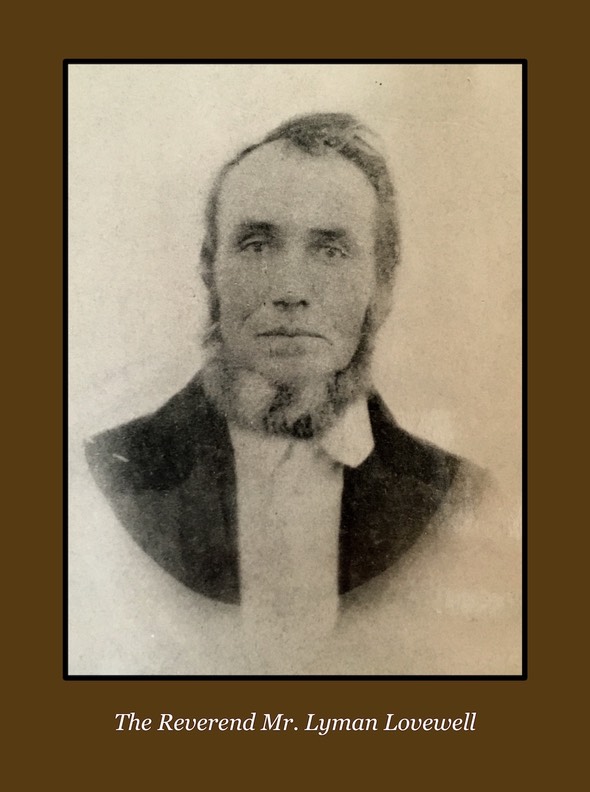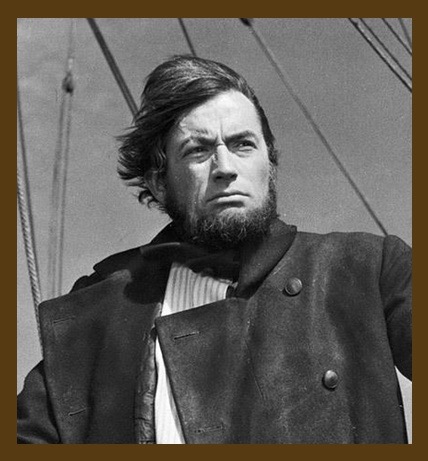
Before putting my month-to-month subscription to Ancestry on hiatus for a time, I logged in and performed a couple of abject last-minute searches. One of the names I typed into the search page was Lyman Lovewell. I hadn’t checked on Lyman in a while, even though his name keeps coming up as I write about the brief relocation of some Lovewells and Davises from Iowa to Marshall County, Kansas Territory, in 1856.
What turned up was something I’ve looked for but never expected to see, a handsome photographic portrait of the Congregationalist minister himself, his face framed by the whiskers and sideburns we associate with Abraham Lincoln, although wearing them made Lyman resemble no one quite so much as Gregory Peck playing the role of Captain Ahab in “Moby Dick.”

Gregory Peck as Ahab
Add a scar and a scowl to Rev. Lyman Lovewell and he could have doubled for Peck in John Huston’s film of “Moby Dick.” Gregory Peck wore chin whiskers on at least one more occasion, playing Abraham Lincoln in the CBS miniseries “The Blue and the Gray."
Peck was criticized for tackling the part of the obsessive captain of the Pequod because he seemed just too nice a man to be leading a salty crew on a vengeful quest for the Great White Whale. We might say the same thing about Lyman: I’ve referred to him before as an abolitionist firebrand, but his portrait exudes polite resolve, temperance, intelligence, and patience. And while we probably wouldn’t join his crew on a bloodthirsty chase around the globe aboard a doomed whaling ship, he’s exactly the sort of charismatic, imperturbable and kindly figure we might follow into the proslavery maw of Marshall County to help bring Kansas into the Union as a free state.
The photograph was posted on the public pages of Ancestry this past January by a member of the Peters branch of Lovewell descendants, by way of Lyman’s daughter Eunetia Annette, the only one of Lyman Loveland Lovewell’s children who was not given a delightfully alliterative name. Lyman's offspring, in order of birth, included Laura Louise; the first of two young Lymans, Lyman Dewey (who died in early childhood); Lucien Dewey; Lucia Maria; then Eunetia Annette; and finally Lyman Otis. The Peters family tree is worth a look from anyone interested in Lyman Lovewell, containing as it does excellent portraits of not just Lyman and his wife, the former Betsy Baldwin Dewey, but their daughters Laura Louise and Eunetia Annette.
The portrait which is presented on Ancestry as a likeness of Lyman Lovewell, does indeed suggest a man who might preach a sermon on the evils of slavery, although I was more firmly convinced of the identification by the many points of similarity between the face in the picture and that of Lyman Lovewell's nephew Thomas, seen in the banner at the top of the page and elsewhere in this site. Each of the two men has wide cheekbones, a prominent brow ridge, high forehead, a blunt nose, and a wide mouth. I had never thought of Thomas Lovewell’s mouth as being wide before, because in photographs it is always veiled by a thick mustache, but given the way that the creases around his mouth sweep far back along the sides his face, the flesh behind that mustache probably resembled the upper lip on display in the portrait of Lyman Lovewell.
Since Lyman died of typhoid fever at the age of fifty in 1862, and the photograph shows his whiskers to be streaked with gray, it might represent the Reverend Mr. Lovewell as he appeared after Lincoln took office and famously changed his own appearance by letting facial hair grow for the first time in his life. A writer on Theappendix.net speculates that Lincoln did not grow whiskers to “signify maturity, statesmanship, or gravitas, but rather urbanity: civilized, metropolitan grace… a rebuttal to claims of rustic rudeness…”
They were whiskers, after all, a cultivated growth, not a beard, which simply meant that a man had stopped shaving. Did Lyman grow his to emulate the transformed Lincoln, or did both men independently adopt an appearance that seemed to suit them? Whatever the reason, the look of chin whiskers and side whiskers with no mustache, what some now term a wreath beard, was one that was also selected by Thomas Lovewell’s brother William, at least for the only known portrait we have of him. And as for Thomas, did he grow a mustache to conceal a wide mouth or disguise a long upper lip, or because he thought it made him look like Kit Carson?